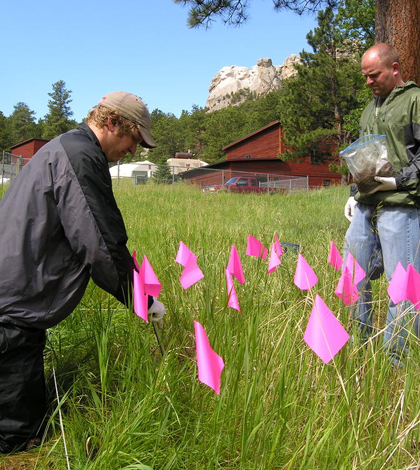At Mount Rushmore, Fireworks Have Affected Water And Soil

USGS scientists collect composite soil samples at Mount Rushmore National Memorial. (Credit: U.S. Geological Survey)
Fireworks are great for celebrating our national pride, but they sometimes have unintended side effects on surrounding water and soil quality.
According to recent research from scientists at the U.S. Geological Survey (USGS), this is even true at secluded spots like Mount Rushmore, where a fireworks display was used to mark Independence Day at the national memorial from 1998 through 2009.
Through water and soil sampling, the scientists have found elevated levels of perchlorate, a compound used as an oxidizing agent in fireworks. It’s also a common component of rocket fuels, explosives and nitrogen-based fertilizers.
At high levels in drinking water, perchlorate can interfere with the function of the human thyroid gland. However, the drinking water at Mount Rushmore meets current regulations and is safe for public consumption.
The USGS and National Park Service studied perchlorate and metals associated with fireworks in 106 water and 11 soil samples taken from Mount Rushmore during 2011-2015. Perchlorate concentrations were greatest in samples collected from the northeast side of the memorial, and the scientists found perchlorate in soil where the fireworks were launched and where the debris landed.

The major drainage basins and sampling locations within the Mount Rushmore National Memorial study area. (Credit: U.S. Geological Survey)
The lack of alternative perchlorate sources in the area, such as from a military site or agricultural land treated with fertilizers, and the presence of firework debris suggest that past fireworks are the main perchlorate source, scientists say. They hope that their results can help park managers protect water quality at the iconic national landmark in the future.
Key findings of the report include:
- A maximum perchlorate concentration of 54 micrograms per liter was measured in a stream sample, and 38 micrograms per liter measured from a groundwater well. In contrast, all groundwater and stream samples collected from sites outside the memorial boundary had perchlorate concentrations less than 0.2 micrograms per liter.
- Concentrations of metals in water samples were similar at sites within and outside the memorial, indicating little evidence of metal contamination due to human-made factors.
- Dynamite that was used to blast the memorial in the 1930s is not a likely source of the perchlorate because perchlorate is not a component of dynamite formulations.
- Drinking water is provided to about 3 million visitors to the memorial every year and to year-round park personnel. Perchlorate in drinking water is not currently regulated by the U.S. Environmental Protection Agency, but the park has planned for additional voluntary monitoring and treatment.
Full results of the effort are published online and available for free to the public.
Top image: USGS scientists collect composite soil samples at Mount Rushmore National Memorial. (Credit: U.S. Geological Survey)




0 comments